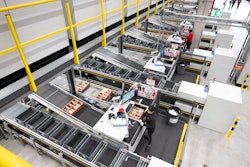
The e-commerce boom and global supply chain disruptions of the past few years have put a spotlight on the importance of warehousing and logistics, but it’s also highlighted the importance of safety and the many risks that warehousing employees face. In fact, according to a recent survey from the U.S. Government Accountability Office (GAO), the transportation and warehousing industry has the highest estimated injury rate among the private sector. With safety considerations such as equipment accidents, overexertion, exposure to hazardous material, and more, facility managers have their hands full. However, there’s another critical component of warehouse safety: pest management. By understanding the pests that are common in warehouses (no matter the industry), the risks they cause to your business and employees, and ways to help prevent and address an issue, you can make pest management a pillar of your warehouse safety program.
Warehouses are massive buildings, ranging from 10,000 square feet to well into the millions. With that much space, there are plenty of entry points and crevices for pests to hide. Some of the common pests you might experience in your warehouse are:
· Insects: There are a wide variety of insects that can cause trouble in a warehouse, including cockroaches, flies, ants, beetles, and more. While some, like cockroaches and flies, present risks to employee health, others, such as ants and beetles, can actually cause other kinds of damage. Depending on the kind of product processed in your warehouse, beetles can even cause damage to inventory.
· Rodents: While many warehouses have loading docks and receiving areas with large doors and windows, rats and mice only need a space the size of a coin to get inside. So, those large open doors provide easy access for these rodents. Once inside, they can reproduce quickly, so it’s important to keep mice and rats away before their populations grow.
· Birds: Birds, such as sparrows, pigeons, and starlings, like to build nests in the rafters of warehouses, and they can be hard to reach in high ceilings. Not only do birds spread disease, but their droppings can contaminate products and cause damage to your building structure.
Pests can be a nuisance, but they also cause larger problems for the health and safety of your employees:
· Transmitting disease: Keeping employees safe is a paramount concern for facility managers, but pests can make it a challenge. Cockroaches, flies, and rodents like to hang out in trash areas, sewers, and dirty drains, carrying dozens of types of bacteria, parasitic worms, and pathogens with them. Birds also transmit more than 60 human pathogenic diseases, such as salmonellosis, chlamydiosis, and avian influenza (better known as bird flu). The presence of pests can infect employees, leading to severe illness and associated downtime, and can even contaminate products, resulting in lost profits.
· Growth of fungi: Bird droppings may cause an unpleasant working environment, but it can also encourage the growth of the fungus Histoplasma capsulatum. This fungus expels spores that can cause respiratory disease when inhaled. Geese create two to four pounds of waste per day, and if it gets into your facility’s water source, it can lead to algae bloom.
· Slip-and-fall risks: According to the same survey by GAO, falls, slips, and trips are one of the three major hazards in a warehouse facility. Bird droppings accumulate over time and can become a slippery liability.
Thankfully, there are ways to help prevent and address a pest issue before it becomes a risk to your facility:
· Proper sanitation and cleaning: Pests are attracted to food, water, and shelter, so by maintaining a strict sanitation and cleaning process, you can eliminate two of their main attractants. Remove trash and waste quickly, keep drains clean, and don’t forget to tidy up the break room! Also, by training staff on pest warning signs and ways they can help prevent an issue, you can help reduce the chance of a pest introduction becoming an infestation.
· Seal entry points: Pests are sneaky and can find a way inside almost any building. To help keep pests out of your warehouse, you need to identify cracks and crevices where they could get in and seal them up.
· Professional assistance: In this industry, you know the importance of modern technology. If one pest sighting has turned into a larger issue, don’t delay in bringing in the professionals. A pest issue can develop into an infestation quickly, so it’s important to know when to bring in a pest management provider. And it’s a no-brainer to bring one in that is constantly innovating and developing new strategies using modern technology. Bioremediation, remote monitoring, and CO2 rodent control are just a few of the ways a modern pest management partner can help protect your warehouse.
Warehouse safety goes beyond hard hats and steel-toed boots; a comprehensive pest management approach is critical to help keep employees safe. When it comes to warehouse safety, even the smallest intruders can create big risks.




















